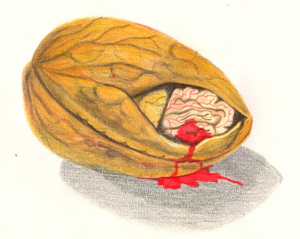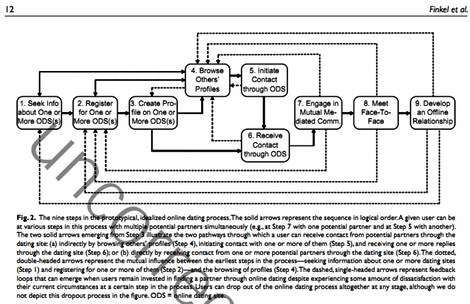Marc Abrahams's Blog, page 597
February 11, 2012
Dead in one country, but still alive in another
"Apparently a patient can be dead in one country, but still alive in another, under the same circumstances," writes Dr. Erwin Kompanje of Rotterdam, The Netherlands, in his essay "How dead is a brain dead patient?"

February 10, 2012
Rubber ducks in oceanography and finance
A song about the Ebbesmeyer analysis of rubber ducks and ocean currents:
A demonstration in which a Salmon (Felix Salmon) uses rubber ducks in water to explain the Greek financial crisis:
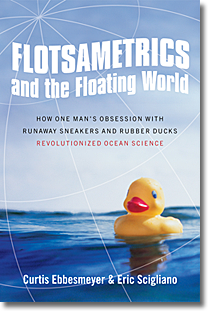 Ebbesmeyer's book about the ducks and the sea:
Ebbesmeyer's book about the ducks and the sea:

Scott Hampton joins LFHCfS
Scott Hampton has joined the Luxuriant Flowing Hair Club for Scientists (LFHCfS). He says:
I guess it's time to take the plunge. Although the ongoing work in ophthalmology is my central career passion, my interest in long hair pre-dates the work on eye implants or drug delivery, and includes recent discoveries in long hair care such as sulfate-free shampoo and co-washing. Recent scientific work has resulted in patents pending for linear sustained release of biologic drugs.
Scott Hampton, LFHCfS
Chairman
TheraKine.com
Cumming, Georgia, USA


Old, old, old age in clones
"We estimated these large clones to be hundreds to thousands of years old", says the study"
"Implications of Extreme Life Span in Clonal Organisms: Millenary Clones in Meadows of the Threatened Seagrass Posidonia oceanica," Sophie Arnaud-Haond [pictured here], Carlos Duarte, Elena Diaz-Almela, Nuria Marbà, Tomas Sintes, et al. (2012) PLoS ONE 7(2): e30454.
(Thanks to investigator Mike Livstone for bringing this to our attention.)

Spaghetti Plot Alternatives
When differing longitudinal graphs are overlayed – in order to visualise data from a large number of sauces sources – the results can become confusing – possibly even meaningless. The outcome, in the parlance of data analysts, has turned into a so-called 'Spaghetti Plot'. (see pic below)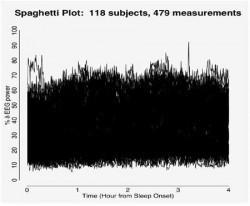
But Bruce J. Swihart and his colleagues Brian Caffo, Bryan D. James, Matthew Strand, Brian S. Schwartz, Naresh M. Punjabi at the Johns Hopkins University Bloomberg School of Public Health, Department of Biostatistics, Baltimore, USA, have between them created a new recipe for epidemiologists – who may now be able to avoid becoming embroiled in spaghetti plots, by using instead the team's newly created 'Lasagna plot' method, which as the picture below shows, is substantially less bewildering. And more colourful too.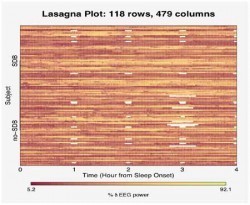
The team's paper Lasagna plots: A saucy alternative to spaghetti plots is published in the journal Epidemiology. September 2010 – Volume 21 – Issue 5 – pp 621-625.
Supporting info here

February 9, 2012
Effect of zebra stripes on horseflies
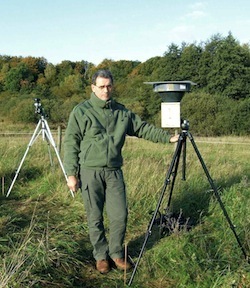 In a relative sense, zebra stripes repel horseflies. That's the latest discovery reported by Gábor Horváth [pictured here], who discovered that white horses attract fewer flies, and that Vikings knew a thing or two about how to use light for ship navigation. For details, see the study:
In a relative sense, zebra stripes repel horseflies. That's the latest discovery reported by Gábor Horváth [pictured here], who discovered that white horses attract fewer flies, and that Vikings knew a thing or two about how to use light for ship navigation. For details, see the study:
"Polarotactic tabanids find striped patterns with brightness and/or polarization modulation least attractive: an advantage of zebra stripes," Ádám Egri, Miklós Blahó, György Kriska, Róbert Farkas, Mónika Gyurkovszky, Susanne Åkesson and Gábor Horváth, Journal of Experimental Biology, vol. 215, March 2012, pp. 736-745.
"The characteristic striped appearance of zebras has provoked much speculation about its function and why the pattern has evolved, but experimental evidence is scarce. Here, we demonstrate that a zebra-striped horse model attracts far fewer horseflies (tabanids) than either homogeneous black, brown, grey or white equivalents."
Victoria Gill of the BBC offers a take on this:
Why zebras evolved their characteristic black-and-white stripes has been the subject of decades of debate among scientists. Now researchers from Hungary and Sweden claim to have solved the mystery. The stripes, they say, came about to keep away blood-sucking flies. They report in the Journal of Experimental Biology that this pattern of narrow stripes makes zebras "unattractive" to the flies. They key to this effect is in how the striped patterns reflect light….

(Thanks to investigator Hugh Henry for bringing this to our attention.)

No words: Oppositional Defiant Disorder
Will anyone be angry, irritable, annoyed or defiant enough to oppose this proposed revision to the DSM (The American Psychiatric Association's Diagnostic and Statistical Manual of Mental Disorders?
Q 00 Oppositional Defiant Disorder
Proposed RevisionA. A persistent pattern of angry and irritable mood along with defiant and vindictive behavior as evidenced by four (or more) of the following symptoms being displayed with one or more persons other than siblings.
Angry/Irritable Mood
1. Loses temper
2. Is touchy or easily annoyed by others.
3. Is angry and resentful
Defiant/Headstrong Behavior
4. Argues with adults
5. Actively defies or refuses to comply with adults' request or rules
6. Deliberately annoys people
7. Blames others for his or her mistakes or misbehavior
Vindictiveness
8. Has been spiteful or vindictive at least twice within the past six months…
[HT the agreeable Charles Seife]
BONUS: More about the proposed new version of the DSM

What the Wug Test wrought, apparently
The Wug Test, a simple, powerful innovation in linguistics, has inspired thought and inspiration.
The Wug Test might, some day, inspire someone to create music. In the meantime, it has inspired the Wug Song:
BACKGROUND: This is the Wug Test:
This is the inventor of the Wug Test:

Psychologists' verdict (and so on) on online dating
The American Psychological Association has lots to say about the online dating industry, and is rushing to say it just as Valentine's Day approaches:
1. A press release:
PRESS RELEASE
February 6, 2012 — For Immediate Release
Grading The Online Dating IndustryNew Scientific Report Finds Some Positives, Many Areas for Improvement
The report card is in, and the online dating industry won't be putting this one on the fridge. A new scientific report concludes that although online dating offers users some very real benefits, it falls far short of its potential….
2. The study described in the press release:
Online Dating: A Critical Analysis From the Perspective of Psychological Science
By Eli J. Finkel [pictured here] (Northwestern University), Paul W. Eastwick (Texas A & M University), Benjamin R. Karney (UCLA), Harry T. Reis (University of Rochester), and Susan Sprecher (Illinois State University). They write:
"Online dating sites frequently claim that they have fundamentally altered the dating landscape for the better. This article employs psychological science to examine (a) whether online dating is fundamentally different from conventional offline dating and (b) whether online dating promotes better romantic outcomes than conventional offline dating. The answer to the first question (uniqueness) is yes, and the answer to the second question (superiority) is yes and no…."
Here is some detail from the study:
3. An announcement that they will soon have an editorial about the study described in the press release:
Editorial: Online Dating: The Current Status —and BeyondBy Arthur Aron
Read the Full Text (Coming Soon)
(HT Vaughan Bell)

Greenhouse gasses on about trays
John Greenhouse gasses on about trays, in the very first words of his patent, #55565, issued on June 4, 1907: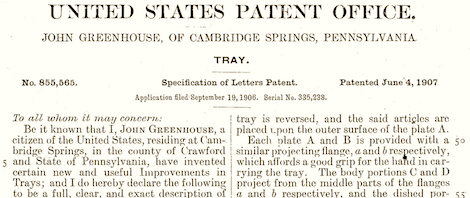
To nil whom it may concern:
Be it known that I, John Greenhouse, a citizen of the United States, residing at Cambridge. Springs, in the county of Crawford and State of Pennsylvania, have invented certain new and useful Improvements in Trays; and I do hereby declare the following to be a full, clear, and exact description of the invention, such as will enable others to skilled in the art to which it appertains to make and use the same….
BONUS (unrelated): Goodall's mathematical calculation (involving greenhouse gasses)) of how walking does more than driving to cause global warming

Marc Abrahams's Blog
- Marc Abrahams's profile
- 14 followers


